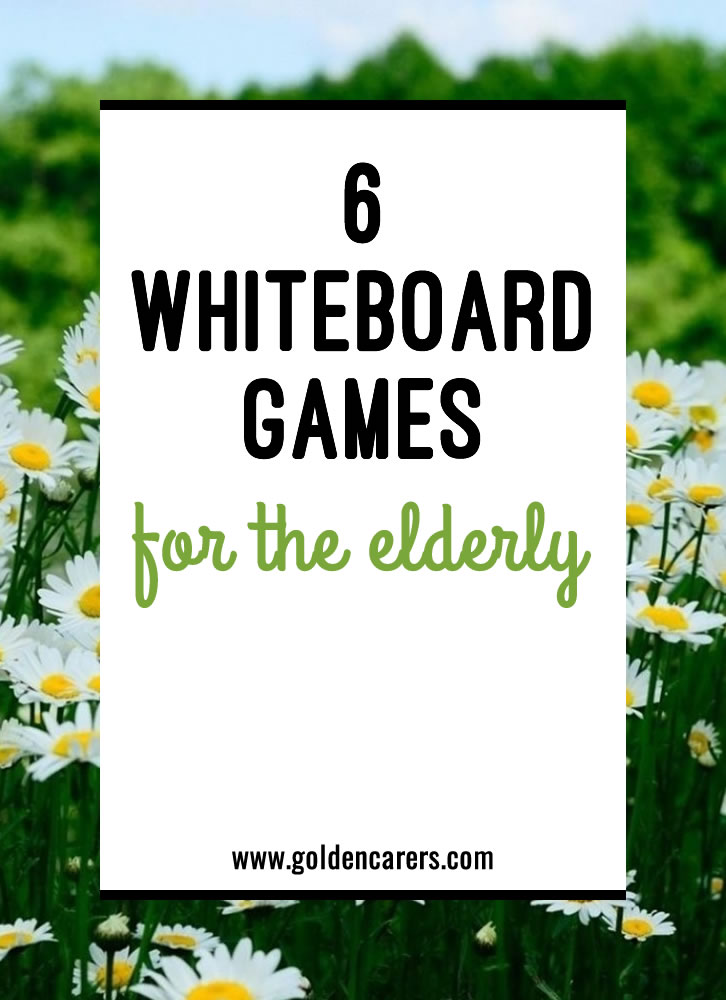6 Whiteboard Games for the Elderly

Whiteboards - also called dry-erase boards - became very popular in the 1990s when they were widely adopted by the education sector. They were seen as a cleaner and more convenient alternative to blackboards following concerns that chalk dust may cause allergies and damage computers.
Whiteboards are effective in settings that require quick and spontaneous feedback. They are an indispensable tool for Activity Coordinators and can be used for group activities, communication and learning.
Advantages of Whiteboards
- Being white, they evoke cleanliness
- Excellent written visibility
- Different coloured markers can be used to enhance visual display
- Markers come with colored lids for instant recognition
- Easily erased
- Can be used to display and interact with content from a projector
- Surfaces are often magnetic, providing more ways to present information
Beware of permanent markers! It is wise to place a note nearby saying
"Please Do Not Use Permanent Markers".
Types of Whiteboards
Melamine - Usually the preferred whiteboard in care facilities for their affordability. They have a laminated coating that eventually wears down, leading to ghosting and difficulty wiping away all marks. This, however can be delayed by cleaning the board regularly. Many melamine whiteboards come with magnetic surfaces to serve other purposes.
Porcelain - Made of white ceramic and steel and offering a magnetic surface. Porcelain whiteboards are durable and more resistant to wearing down. They suitable for heavy use but cost more than melamine boards.
Glass - Made of tempered glass for durability. These are the most expensive of all boards but will not streak or ghost.
Whiteboards and Their Many Uses
Activity Coordinators use Whiteboards to:
- Improve communication with clients and peers
- Make announcements and requests
- Assist in meetings and presentations
- Leave messages for staff on different shifts
- Educate peers and clients
- Play games
Whiteboards are sometimes on wheels and if that is the case keep the wheels locked at all times and avoid moving it about, for safety reasons.
Whiteboards are robust but at the same time, lightweight, and come in a variety of sizes. They don't require any special products - any office supply store will stock coloured whiteboard markers and cleaning products.
Five Games for Whiteboards to Play
Here are a few ideas, adapt them to your needs, make them as easy or difficult as you need!
1. Jeopardy

Based on the TV game show, this quiz style game is fun and requires some focus and general knowledge. Divide whiteboard into columns and write down the categories and points as per image. Print questions supplied. Divide participants into two teams; each team takes turns choosing the category and points they want to play. Answers should be given in the trademark Jeopardy style: "What is ....?". Cross-off the points if they answer correctly and add them to the team's tally. The team with the most points at the end of the game is the winner.
2. Suction Cup Ball
Fun and inexpensive, suction balls are versatile, light, and easy to use.
They can be played by two teams and it is non-competitive.
Write large syllables and letters on the whiteboard and participants (one at a time) throw the ball. Wherever the ball lands (syllable or letter) they have to come up with a word using that syllable or the letter.
3. Hot Seat
One participant sits with his/her back to the board. The Activity Coordinator writes a well known movie title on the board and asks another participant to describe the movie's plot to the 'Hot Seat' participant. Words and gestures only can used to describe the movie.
4. Hangman
A popular game for any age.
Ask one participant to think of a secret word and write blank spaces on the board to represent each letter. Participants take turns guessing a letter. Fill in the blanks as the letters are guessed. Each time a letter is guessed that does not belong to the word, draw one line of your hangman. The object of the game is to complete the word before the full hangman is drawn.
5. Blindfold Game
Draw a large flower on the board with a bee in the centre. Challenge participants to find the bee whilst blindfolded. Vary the game by writing in huge letters the brand of a car or the name of a city or country or a surname with one letter missing e.g. Toy--ta or Parag--ay, then give the participant a marker for him to write the missing letter while blindfolded.
6. Word Games
There are so many fabulous word games that can be played using a whiteboard! Here are some popular ones:
Words in Words Game
Whiteboard Word Game
Guess the Word
Whiteboard Word Quiz






The residents love these word games, thank you being an endless source of enjoyment, knowledge and creativity.
We have started doing pictionary. Each table of residents is a team, they take turns drawing a piece of paper out of a bowl *no looking*, I draw it and the teams take turns guessing it. They love it, we play it once a month now.
I am really impressed with Golden Carers, you never run out of idea and always prompting us with new activities.
Thank you so very much for your feedback Honorine, this means so much to us x
How is jeopardy played.
Help
Joan fox.
Hi Jean
I think this information will help you
https://tag.rutgers.edu/wp-content/uploads/2014/05/Jeopardy-instructions.pdf
My residents who are in mild to moderate stages of dementia in an assisted living home in Toronto, Canada.
They love Hangman, they felt really challenged in a good way and are glad when they are not hung, which I never allow them to be as I give them many hints, but they also strive more cause they do not want to get hung!! It's a real favorite, they could play for hours!
Thank you
Marian
Jeopardy was a huge success!!!!! Thanks so much!
Thanks so much for your feedback Jenny!
Thanks for putting together the Jeopardy game. One can tell it will be a success even before trying it out!
Thanks so much for your feedback Judy!
Thank you Tara
It is great that you enjoy working with the elderly and that you can provide meaningful activities for them
There are many great ideas that you will be able to use
Hello everyone,
Just wanted to thank you all those who they have put this site together.
It makes life easy and save's time.
It has been rough Journey to start but by god, it is the best thing that I have invested on.
Helping the elderly to have a meaningful time, a bit of laughter and a sense of achievement.
I do thank you and appreciate all you have done.
Thank you so very much for your feedback Tara, it means so much to us! Please let us know if there's anything else you would like to see here and we'd love for you to share your favorite activities too. All the best!
Hi this looks a very good game can't wait to try it...we play pictionary on the white board we have two teams and my colleague and i do all the drawing, this is really fun as we can't draw.
I can relate to this! It's even more fun when you can't draw very well!
LOVED the Jeaopardy game!!! It went over very well with our folks and thank you for taking the time to create it. I am wondering if there are more questions coming? I can create my own but kind of fun to get someone else's perspective. Thanks! :)
Check out this for a fun game of Jeopardy . I let the residents hold on to their winning number and add up the the score for the two teams. Its been Fab!
https://www.cdsboutique.com/en/super-quiz-mat-3-quiz-books.html
Hi, Marita, we are so glad this activity worked for you. Thank you very much for the feedback and your kind words. There will be more questions soon.
Yesterday we used the whiteboard, didn't get a great reception to start with.
I wrote my name (Donna) down and asked what the first thing starting with D that came into their mind and when we completed my name I read it out as a little story.
The residents and volunteers and a family member all lauged and then thay all wanted to see what story would come out of there names.
Thankyou for the great idea it was a such an interactive activity.
Donna
I'm going to try this, Donna. Thanks for the share. I'll be calling it "The story of a name".
Great idea!
will have to try that Donna sounds fun.
That's such a creative idea Donna - I love this! Well done!
We played jeopardy yesterday.......was a lot of fun. Will play again.
Thanks for your feedback Meredith!
Jeopardy looks like it could be great fun but I can't work out how to play it! Do you need to be familiar with it as a TV game show or am I just not understanding the instructions?! Any help much appreciated. Thanks!
We do Jeopardy like this at our facility. We have trivia books that we take questions from as they are more appropriate for our mental status than regular Jeopardy. Most trivia books are categorized.
Hi Amy, I guess it would be very helpful if you could watch a few episodes of the TV series ‘Jeopardy.’ You could also find someone acquainted with the game to go through with you. It is not difficult. Meanwhile, you can just use the game as a Quiz.
Thank you so much for the feedback everyone, it's wonderful to hear these games have been well received by your clients!
I tried yesterday the jeopardy game it was a blast even aides joined it was great thank thank you
Thank you for this game, I have used it with 2 separate groups with differing cognitive abilities including dementia and all participants loved it. I have now been asked for new questions to add. Thank you again Christine
Great ideas.Our residents love playing how many words can you make from one word.e.g
Steaming
This is what we do with one of our whiteboards using the monthly facts and games sheets from this website. We have many whiteboards littered throughout our centre and love using them so thanks for the ideas!
Love this idea, thanks
Thankyou these games are a lot of fun :)
Hi, the jeopardy game is really inviting. I'd like to do it.
Great whiteboard games.
We use a white board a lot in our place. Our residents also like easy versions of Pictionary type games as well. These drawing games can be themed around holidays as well.
Thank you for the white board games. I am looking forward to playing jeopardy with my clients soon.